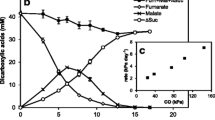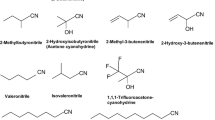Abstract
The initial reactions involved in anaerobic aniline degradation by the sulfate-reducing Desulfobacterium anilini were studied. Experiments for substrate induction indicated the presence of a common pathway for aniline and 4-aminobenzoate, different from that for degradation of 2-aminobenzoate, 2-hydroxybenzoate, 4-hydroxybenzoate, or phenol. Degradation of aniline by dense cell suspensions depended on CO2 whereas 4-aminobenzoate degradation did not. If acetyl-CoA oxidation was inhibited by cyanide, benzoate accumulated during degradation of aniline or 4-aminobenzoate, indicating an initial carboxylation of aniline to 4-aminobenzoate, and further degradation via benzoate of both substrates. Extracts of alinine or 4-aminobenzoategrown cells activated 4-aminobenzoate to 4-aminobenzoyl-CoA in the presence of CoA, ATP and Mg2+. 4-Aminobenzoyl-CoA-synthetase showed a K m for 4-aminobenzoate lower than 10 μM and an activity of 15.8 nmol · min-1 · mg-1. 4-Aminobenzoyl-CoA was reductively deaminated to benzoyl-CoA by cell extracts in the presence of low-potential electron donors such as titanium citrate or cobalt sepulchrate (2.1 nmol · min-1 · mg-1). Lower activities for the reductive deamination were measured with NADH or NADPH. Reductive deamination was also indicated by benzoate accumulation during 4-aminobenzoate degradation in cell suspensions under sulfate limitation. The results provide evidence that aniline is degraded via carboxylation to 4-aminobenzoate, which is activated to 4-aminobenzoyl-CoA and further metabolized by reductive deamination to benzoyl-CoA.
Similar content being viewed by others
References
AokiK, KemoriT, ShinkeR NishiraH (1985) Further characterization of bacterial production of anthranillic acid from aniline. Agric Biol Chem 49: 1151–1158
BackoferR, LingensF, SchäferW (1975) Conversion of aniline into pyrocatechol by Nocardia sp., incorporation of oxygen-18. FEBS Lett 50: 288–290
BollagJM, RusselS (1975) Aerobic versus anaerobic metabolism of halogenate anilines by a Paracoccus sp. Microbiol Ecol 3: 65–73
BradfordMM (1976) A rapid and sensitive method for the quantitation of microgram quantities of protein utilizing the principle of protein-dye binding. Anal Biochem 72: 248–254
FranckHG, StadelhoferJW (1987) Industrielle Aromatenchemie. Springer, Berlin Heidelberg New York
GlöcklerR, TschechA, FuchsG (1989) Reductive dehydroxylation of 4-hydroxybenzoyl-CoA to benzoyl-CoA in a denitrifying, phenol degrading Pseudomonas species. FEBS Lett 251: 237–240
HallasLE, AlexanderM (1983) Microbial transformation of nitroaromatic compounds in sewage effluent. Appl Environ Microbiol 45: 1234–1241
HarwoodCS, GibsonJ (1986) Uptake of benzoate by Rhodopseudomonas palustris grown anaerobically in light. J Bacteriol 165: 504–509
HerbertD, PhippsPJ, StrangeRE (1971) Chemical analysis of microbial cells. In: NorrisJR, RibbonsDW (eds) Methods in microbiology, vol 5B. Academic Press, New York, pp 209–344
JankeD, Al-Mofarji, StraubeG, SchumanP, PrauserH (1988) Critical steps in degradation of chloroaromatics by rhodococci. I. Initial enzyme reactions involved in catabolism of aniline, phenol and benzoate by Rhodococcus sp. An 117 and An213. J Basic Microbiol 28: 509–518
KnollG, WinterJ (1987) Anaerobic degradation of phenol in sewage sludge. Benzoate formation from phenol and CO2 in the presence of hydrogen. Appl Microbiol Biotechnol 25: 384–391
MerkelSM, EberhardAE, GibsonJ, HarwoodCS (1989) Involvement of Coenzyme A thioesters in anaerobic metabolism of 4-hydroxybenzoate by Rhodopseudomonas palustris. J Bacteriol 171: 1–7
Platen H (1989) Abbau von Aceton und höheren aliphatischen Ketonen durch anaerobe Bakterien. PhD thesis, Tübingen, FRG
ReberH, HelmV, KaranthNGK (1979) Comparative studies on the metabolism of aniline and chloroaniline by Pseudomonas multivorans strain An1. Eur J Appl Microbiol Biotechnol 7: 181–189
RobertsDJ, FedorakPM, HrudeySE (1990) CO2 incorporation and 4-hydroxy-2-methylbenzoic acid formation during anaerobic metabolism of m-cresol by a methanogenic consortium. Appl Environ Microbiol 56: 472–478
SchauderR, EikmannsB, ThauerRK, WiddelF, FuchsG (1986) Acetate oxidation to CO2 in anaerobic bacteria via a novel pathway not involving reactions of the citric acid cycle. Arch Microbiol 145: 162–172
SchnellS, BakF, PfennigN (1989) Anaerobic degradation of aniline and dihydroxybenzenes by newly isolated sulfate-reducing bacteria and description of Desulfobacterium anilini. Arch Microbiol 152: 556–563
SzewzykU, SchinkB (1989) Degradation of hydroquinone, gentisate, and benzoate by a fermenting bacterium in pure or defined mixed culture. Arch Microbiol 151: 541–545
ThauerRK, JungermannK, DeckerK (1977) Energy conservation in chemotrophic anaerobic bacteria. Bacteriol Rev 41: 100–180
ThebrathB, DillingW, CypionkaH (1989) Sulfate activation in Desulfotomaculum. Arch Microbiol 152: 296–301
TschechA, FuchsG (1989) Anaerobic degradation of phenol via carboxylation to 4-hydroxybenzoate: in vitro study of isotope exchange between 14CO2 and 4-hydroxybenzoate. Arch Microbiol 152: 594–599
TschechA, SchinkB (1986) Fermentative degradation of monohydroxybenzoates by defined syntrophic cocultures. Arch Microbiol 145: 396–402
TschechA, SchinkB (1988) Methanogenic degradation of anthranilate (2-aminobenzoate) Syst Appl Microbiol 11: 9–12
WebsterLT, MieyalJJJ, SiddiquiUA (1974) Benzoyl and hydroxybenzoyl esters of Coenzyme A. J Biol Chem 249: 2641–2645
WyndhamRC (1986) Evolved aniline catabolism in Acinetobacter calcoaceticus during continuous culture of river water. Appl Environ Microbiol 51: 781–789
ZieglerK, BraunK, BöcklerA, FuchsG (1987) Studies on the anaerobic degradation of benzoic acid and 2-aminobenzoic acid by a denitrifying Pseudomonas strain. Arch Microbiol 149: 62–69
Author information
Authors and Affiliations
Rights and permissions
About this article
Cite this article
Schnell, S., Schink, B. Anaerobic aniline degradation via reductive deamination of 4-aminobenzoyl-CoA in Desulfobacterium anilini . Arch. Microbiol. 155, 183–190 (1991). https://doi.org/10.1007/BF00248615
Received:
Accepted:
Published:
Issue Date:
DOI: https://doi.org/10.1007/BF00248615




